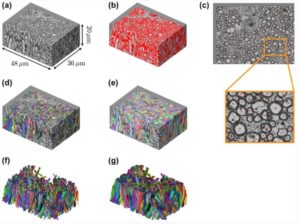
Each year, Brain Structure and Function presents an Editor’s Choice Award in conjunction with the Cajal Club. The winning papers are selected by the journal’s editorial team, with the prize aiming to celebrate early career researchers and recognize their achievements as they progress in the field of neuroscience.
Ordinarily, these awards are presented as part of a ceremony during the Cajal Club’s annual social at the Society for Neuroscience meeting, one of the largest scientific conferences in the world. Proceedings may have moved online this year, but the award was still an excellent opportunity to showcase authors’ valued contributions to the journal.
The selection process for the Editor’s Choice Award is extremely competitive, and consists of multiple stages. Of 222 eligible publications from across 2019, Brain Structure and Function’s Associate Editor team nominated a shortlist of 19 papers.
From the shortlist, four panel members each voted on their top picks, from which the winner and runner up emerged.
This year’s winning papers
The winner of this year’s award is Hong-Hsi Lee, for his article “Along-axon diameter variation and axonal orientation dispersion revealed with 3D electron microscopy: implications for quantifying brain white matter microstructure with histology and diffusion MRI”

In this article, electron microscopy images showing the brains of mice are reconstructed. Previous modeling of neuronal tissue has relied on several assumptions about structure, for example that axons (long projections of nerve cells, or neurons) are perfectly cylindrical and even in diameter, or that the bundles of fibers within the axons are oriented consistently.
However, here an algorithm was developed and applied in order to rapidly segment individual constituents of axons, allowing for the calculation of several size-related parameters. While it was found that the distribution of the orientation of fibers within these axons remains stable along their length, the diameter of the axons varies. This means that in tissue microstructure modeling scenarios, an active area of research bridging the gap between the structure and function of the brain, axons should not be modeled as perfectly cylindrical.
At the time of this research being carried out, Hong-Hsi Lee was undertaking his PhD studies at New York University School of Medicine, advised by Els Fieremans and Dmitry S Novikov.
Now a Post-Doctoral Fellow at NYU, Hong-Hsi’s research projects continue to focus on the validation of biophysical models, analyzing numerical simulations in order to confirm or challenge various assumptions made in their design. Having developed a framework relevant to 3D cells organelles, he is now collaborating with Susie Y. Huang at Massachusetts General Hospital and Jeff W. Lichtman at Harvard University to extend this knowledge into human brain tissues, with promising preliminary results.

Additionally, drawing on his statistical modeling skills and further expertise having completed an MD with the National Taiwan University, Dr Lee has undertaken an additional research project this year, looking at the collateral effects of measures against COVID-19 on common infections. His analysis of Taiwan’s National Health Insurance database showed that following the implementation of measures such as mask wearing and regular hand washing, rates of hospitalization due to other infections have been significantly decreased.
This year’s runner up prize for the Editors’ Choice Award went to Habon Issa, for her work as first author on an article comparing the brain microstructure of bonobo and chimpanzees, revealing differences in socio-emotional circuits.

While humans’ closest living relatives, chimpanzees and bonobos, are also closely related to each other, they show several important differences in behavior. Bonobos’ social tolerance is high, while chimpanzees are indicated to be more aggressive and territorial.
This study in the journal compared bonobo and chimpanzee brain microstructure, by looking at the ratio of tissue area occupied by structural elements like axons and synapses, against area occupied by cell bodies.
It was found that a higher proportion of axons, dendrites and synapses were found in specific regions of the bonobo brain when directly compared to those regions in the chimpanzee brain. This supports the hypothesis that comparatively increased presence of these connective elements may reflect variation in behavior between bonobos and chimpanzees.
When the research for this article was undertaken, Habon Issa was an undergraduate student at the George Washington University, something senior author Chet Sherwood noted as being particularly impressive upon her nomination for the award.

At the time of the article’s publication, Habon had moved on to become a research technician in Mark Wu’s lab at John Hopkins University, studying genes influencing sleep timing and drive. Following on from this, she moved to New York University to begin a PhD with Robert Froemke’s lab, identifying the neurons behind maternal motivation for interaction with young.
The key themes running through Habon’s experiences are her interest in the neuroanatomy, genes and molecular mechanisms relating to social and naturalistic behaviors.
Could you be a winner?
We’re delighted that Hong-Hsi and Habon both published their research with Brain Structure and Function, and wish them both the best for their future research careers. The Editors’ Choice Award runs annually – all submissions published in the previous year are eligible for nomination providing that they have a first author who is within the first ten years of their research career.
Want to be in with a chance to be considered for a future Editors’ Choice Award? Find out more about submitting to Brain Structure and Function.
Amy Joint
She studied Zoology at the University of Bristol, and in a previous life was a Stage Manager.
Latest posts by Amy Joint (see all)
- What makes a prize-winning paper? Observations from the 2020 Brain Structure and Function Editors’ Choice Award - 30th November 2020
- Brain Awareness Week 2020: Cognitive function and commercial video games - 16th March 2020
- Q&A with Professor Kathryn Roeder - 30th April 2019
Comments